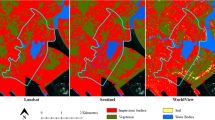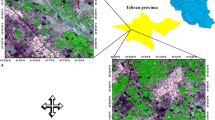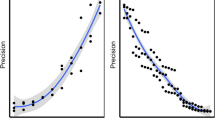Abstract
Performance evaluation is a critical step when developing land-use and cover change (LUCC) models. The present study proposes a spatially explicit model performance evaluation method, adopting a landscape metric-based approach. To quantify GEOMOD model performance, a set of composition- and configuration-based landscape metrics including number of patches, edge density, mean Euclidean nearest neighbor distance, largest patch index, class area, landscape shape index, and splitting index were employed. The model takes advantage of three decision rules including neighborhood effect, persistence of change direction, and urbanization suitability values. According to the results, while class area, largest patch index, and splitting indices demonstrated insignificant differences between spatial pattern of ground truth and simulated layers, there was a considerable inconsistency between simulation results and real dataset in terms of the remaining metrics. Specifically, simulation outputs were simplistic and the model tended to underestimate number of developed patches by producing a more compact landscape. Landscape-metric-based performance evaluation produces more detailed information (compared to conventional indices such as the Kappa index and overall accuracy) on the model’s behavior in replicating spatial heterogeneity features of a landscape such as frequency, fragmentation, isolation, and density. Finally, as the main characteristic of the proposed method, landscape metrics employ the maximum potential of observed and simulated layers for a performance evaluation procedure, provide a basis for more robust interpretation of a calibration process, and also deepen modeler insight into the main strengths and pitfalls of a specific land-use change model when simulating a spatiotemporal phenomenon.





Similar content being viewed by others
References
Al-ahmadi, K., See, L., Heppenstall, A., & Hogg, J. (2008). Calibration of a fuzzy cellular automata model of urban dynamics in Saudi Arabia. Ecological Complexity, 6(2), 80–101.
Al-shalabi, L., Billa, L., Pradhan, B., Mansor, S., & Al-sharif, A. A. A. (2012). Modelling urban growth evolution and land-use changes using GIS based cellular automata and SLEUTH models: the case of Sana’a metropolitan city, Yemen. Environmental Earth Sciences, 70(1), 425–437.
Asgarian, A., Amiri, B. J., & Sakieh, Y. (2014). Assessing the effect of green cover spatial patterns on urban land surface temperature using landscape metrics approach. Urban Ecosystems, 18(1), 209–222.
Botequila, A. l., Miller, J., Ahem, J., & McGarigal, K. (2006). Measuring landscapes: a planner’s handbook. Washington: Island Press. 272p.
Clarke, K. C., Hoppen, S., & Gaydos, L. (1997). A self-modifying cellular automaton model of historical urbanization in the San Francisco Bay area. Journal of Environment and Planning B: Planning & Design, 24(2), 247–261.
Dezhkam, S., Amiri, B. J., Darvishsefat, A. A., & Sakieh, Y. (2014). Simulating urban growth dimensions and scenario prediction: a case study of Rasht County, Guilan, Iran. Geojournal, 79(5), 591–604.
Dibari, J. N. (2007). Evaluation of five landscape-level metrics for measuring the effects of urbanization on landscape structure: the case of Tucson, Arizona, USA. Landscape and Urban Planning, 79(3–4), 308–313.
Dietzel, C., Herold, M., Hemphill, J. J., & Clarke, K. C. (2005). Spatio-temporal dynamics in California’s Central Valley: empirical links to urban theory. International Journal of Geographic Information Science, 19(2), 175–195.
Eastman, R. (2009). Idrisi Taiga Version 16.01, Clark Laboratories, Clark University, Worcester, MA.
Farina, A. (2006). Principles and methods in landscape ecology: toward a science of landscape. Netherland: Springer publication. 412p.
Feng, Y., Liu, Y., Tong, X., Liu, M., & Deng, S. (2011). Modeling dynamic urban growth using cellular automata and particle swarm optimization rules. Landscape and Urban Planning, 102(3), 188–196.
Forman, K. E., & Godron, M. (1986). Landscape ecology. New York: Wiley. 432p.
Guan, D., Li, H. F., Inohae, T., Su, W., Nagaie, T., & Hokao, K. (2011). Modeling urban land use change by integration of cellular automata and Markov model. Ecological Modeling, 222(20–22), 3761–3772.
Hasani Sangani, M., Amiri, B. J., Alizadeh Shabani, A., Sakieh, Y., & Ashrafi, S. (2014). Modeling relationships between catchment attributes and river water quality in southern catchments of the Caspian Sea. Environmental Science and Pollution Research, 22(7), 4985–5002.
Herold, M., Couclelis, H., & Clarke, K. C. (2005). The role of spatial metrics in the analysis and modeling of urban land use change. Computers, Environment and Urban Systems, 29(4), 369–399.
Herold, M., Goldstein, N. C., & Clarke, K. C. (2003). The spatiotemporal form of urban growth: measurement, analysis and modeling. Remote Sensing of Environment, 86(3), 286–302.
Herold, M., Scepan, J., & Clarke, K. C. (2002). The use of remote sensing and urban landscape metrics to describe structures and changes in urban land uses. Environment and planning B: planning and design, 34(8), 1443–1458.
Iranian Statistics Center. (2012). General census of population and housing of Karaj City.
Jaafari, S., Sakieh, Y., Shabani, A. A., Danehkar, A., & Nazarisamani, A. (2015). Landscape change assessment of reservation areas using remote sensing and landscape metrics (case study: Jajroud reservation, Iran). Environment, Development and Sustainability. doi:10.1007/s10668-015-9712-4.
Jafarnezhad, J., Salmanmahiny, A., & Sakieh, Y. (2015). Subjectivity versus objectivity—a comparative study between Brute Force method and Genetic Algorithm for calibrating the SLEUTH urban growth model. Urban Planning and development. doi:10.1061/(ASCE)UP.1943-5444.0000307.
Jokar, J., Helbich, A., & Noronha, E. (2013). Spatiotemporal simulation of urban growth patterns using agent-based modeling: the case of Tehran. Cities, 32, 33–42.
Luck, M., & Wu, J. G. (2002). A gradient analysis of urban landscape pattern: a case study from the Phoenix metropolitan region, Arizona, USA. Landscape Ecology, 17(4), 327–339.
Lechner, A. M., Reinke, K. J., Wang, Y., & Bastin, L. (2013). Interactions between landcover pattern and geospatial processing methods: effects on landscape metrics and classification accuracy. Ecological Complexity, 15, 71–82.
Makhdoum, F. M. (2007). Fundamental of land use planning. Tehran: University of Tehran press.
Mahiny, A. S., & Clarke, K. C. (2012). Guiding SLEUTH land-use/land-cover change modeling using multicriteria evaluation: towards dynamic sustainable land-use planning. Environment and planning B: planning and design, 39(5), 925–944.
Mahiny, A. S., & Clarke, K. C. (2013). Simulating hydrologic impacts of urban growth using SLEUTH, multi criteria evaluation and runoff modeling. Journal of Environmental Informatics, 22(1), 27–38.
Mas, J. F., Vega, A. P., & Clark, C. (2010). Assessing “spatially explicit” land use/cover change models. Proceedings of the IUFRO Landscape Ecology Working Group International Conference, Bragança, Portugal.
Mc Garigal, K., & Marks, B. J. (1995). FRAGSTATS: spatial pattern analysis program for quantifying landscape structure, USDA Forest Service.
O’Neill, R. V., Riitters, K. H., Wickham, J. D., & Bruce Jones, K. (1999). Landscape pattern metrics and regional assessment. Ecosystem Health, 5(4), 225–233.
Onsted, J. A., & Chowdhury, R. R. (2014). Dose zoning matter? A comparative analysis of landscape change in Redland, Florida using cellular automata. Landscape and Urban Planning, 121, 1–18.
Pearce, J., & Simon, F. (2000). Evaluating the predictive performance of habitat models developed using logistic regression. Ecological Modelling, 133(3), 225–245.
Pham, H. M., Yamaguchi, Y., & Bui, T. Q. (2011). A case study on the relation between city planning and urban growth using remote sensing and spatial metrics. Landscape and Urban Planning, 100(3), 223–230.
Poelmans, L., & Rompaey, A. (2009). Detecting and modelling spatial patterns of urban sprawl in highly fragmented areas: a case study in the Flunders-Brussels region. Landscape and Urban Planning, 93(1), 10–19.
Pontius, R. G., Jr. (2000). Quantification error versus location error in comparison of categorical maps. Photogrammetric Engineering and Remote Sensing, 66(8), 1011–1016.
Pontius, R. G., Jr., & Batchu, K. (2003). Using the relative operating characteristic to quantify certainty in prediction of location of land cover change in India. Transactions in GIS, 7(4), 467–484.
Pontius, R. G., Jr., & Millones, M. (2011). Death to Kappa: birth of quantity disagreement and allocation disagreement for accuracy assessment. International Journal of Remote Sensing, 32(15), 4407–4429.
Pontius, R. G., Jr., & Schneider, L. C. (2001). Land-cover change model validation by an ROC method for the Ipswich watershed, Massachusetts, USA. Agriculture, Ecosystems and Environment, 85(1–3), 239–248.
Pontius, R. G., Jr., & Si, K. (2014). The total operating characteristic to measure diagnostic ability for multiple thresholds. International Journal of Geographical Information Science, 28(3), 570–583.
Pontius, R. G., Jr., Cornell, D. C., & Hall, C. A. S. (2001). Modeling the spatial pattern of land-use change with GEOMOD2: application and validation for Costa Rica. Agriculture, Ecosystems and Environment, 85(1–3), 191–203.
Rafiee, R., Mahini, A. S., & Khorasani, N. (2009). Assessment of changes in urban green spaces of Mashad city using satellite data. International Journal of Applied Earth Observation and Geoinformation, 11(6), 431–438.
Saaty, T. L. (1980). The analytic hierarchy process: planning, priority setting, resource allocation. New York: McGraw Hill.
Sakieh, Y. (2013). Urban sustainability analysis through the SLEUTH urban growth model and multi criteria evaluation: a case study of Karaj City. Dissertation, University of Tehran.
Sakieh, Y., Amiri, B. J., Danekar, A., Feghhi, J., & Dezhkam, S. (2014a). Scenario-based evaluation of urban development sustainability: An integrative modeling approach to compromise between urbanization suitability index and landscape pattern. Environment, Development and Sustainability, 17(6), 1343–1365.
Sakieh, Y., Amiri, B. J., Danekar, A., Feghhi, J., & Dezhkam, S. (2014b). Simulating urban expansion and scenario prediction using a cellular automata urban growth model, SLEUTH, through a case study of Karaj City, Iran. Housing and Built Environment, 30(4), 591–611.
Sakieh, Y., Salmanmahiny, A., Jafarnezhad, J., Mehri, A., Kamyab, H., & Galdavi, S. (2015). Evaluating the strategy of decentralized urban land-use planning in a developing region. Land Use Policy, 48, 534–551.
Silva, E. A., & Clarke, K. C. (2002). Calibration of the SLEUTH urban growth model for Lisbon and Porto, Portugal. Computers, Environment and Urban Systems, 26(6), 525–552.
Soares-Filho, B. S., Cerqueira, G. C., & Pennachin, C. L. (2002). DINAMICA—a stochastic cellular automata model designed to simulate the landscape dynamics in an Amazonian colonization frontier. Ecological Modelling, 154(3), 217–235.
Stevens, D., & Dragicevic, S. (2007). A GIS-based irregular cellular automata model of land-use change. Environmental and Planning B: Planning and Design, 34(4), 708–724.
Sullivan, D. O., & Torrens, P. M. (2000). Cellular models of urban systems, CASA working paper series, paper 22, available online at: www.casa.ucl.uk.
Su, S., Xiao, R., & Zhang, Y. (2011). Multi-scale analysis of spatially varying relationships between agricultural landscape patterns and urbanization using geographically weighted regression. Applied Geography, 32(2), 360–375.
Tang, J., Wang, L., & Yao, Z. (2008). Analyses of urban landscape dynamics using multi-temporal satellite images: a comparison of two petroleum-oriented cities. Landscape and Urban Planning, 87(4), 269–278.
Tian, G., Ouyang, Y., Quan, Q., & Wu, J. (2011). Simulating spatiotemporal dynamics of urbanization with multi-agent systems—a case study of the Phoenix metropolitan region, USA. Ecological Modelling, 222(5), 1129–1138.
Tobler, W. R. (1969). Geographical filters and their inverses. Geographical Analysis, 1(3), 234–253.
Turner, M. G., Gardner, R. H., & O’Neill, R. V. (2001). Landscape ecology in theory and practice: pattern and process. New York: Springer.
Verburg, P. H., Soepboer, W., Veldkamp, A., Limpiada, R., Espaldon, V., & Mastura, S. S. A. (2002). Modeling the spatial dynamics of regional land use: the CLUE-S model. Environmental Management, 30(3), 391–405.
Wang, H., He, S., Liu, X., Dai, L., Pan, P., Hong, S., & Zhang, W. (2012). Simulating urban expansion using a cloud-based cellular automata model: a case study of Jiangxia, Wuhan, China. Landscape and Urban Planning, 110, 99–112.
Weng, Y. C. (2007). Spatiotemporal changes of landscape pattern in response to urbanization. Landscape and Urban Planning, 81(4), 341–35.
Wu, X., Hu, Y., He, H. S., Bu, R., Onsted, J., & Xi, F. (2009). Performance evaluation of the SLEUTH model in the Shenyang metropolitan area of northeastern China. Environmental Modeling and Assessment, 14(2), 221–230.
Zadeh, L. A. (1965). Fuzzy sets. Information and Control, 8(3), 338–353.
Author information
Authors and Affiliations
Corresponding author
Ethics declarations
Conflict of interest
The authors declare that they have no conflict of interest.
Rights and permissions
About this article
Cite this article
Sakieh, Y., Salmanmahiny, A. Performance assessment of geospatial simulation models of land-use change—a landscape metric-based approach. Environ Monit Assess 188, 169 (2016). https://doi.org/10.1007/s10661-016-5179-5
Received:
Accepted:
Published:
DOI: https://doi.org/10.1007/s10661-016-5179-5




